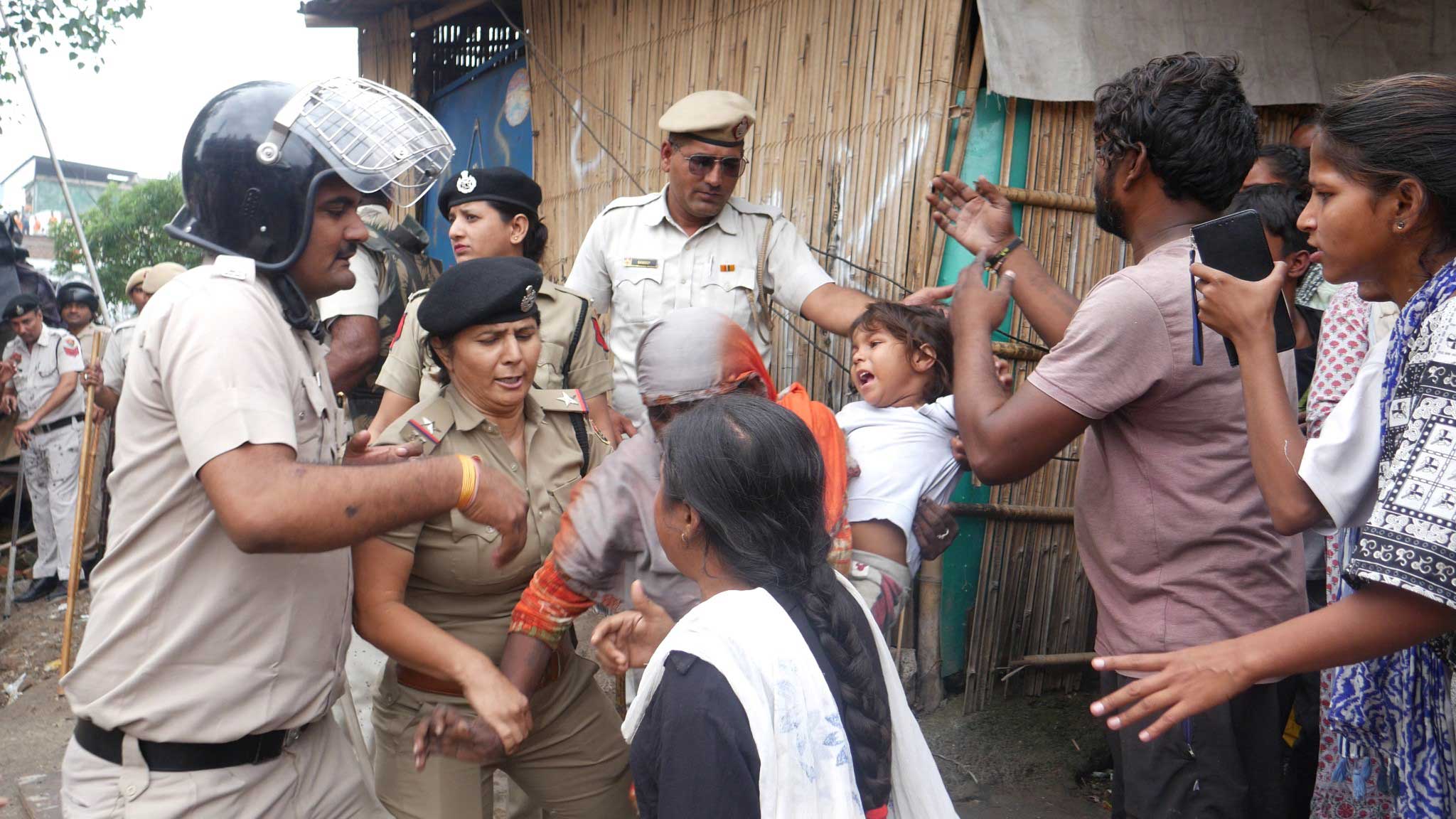October 8, 2025, Gurugram, Haryana: On Wednesday in Gurugram’s Sector 12, on Old Delhi Road, homes were razed down after residents were forcibly dragged out by a massive police force, in yet another case of demolition and forced evictions in India following the 2024 Supreme Court judgement that deemed them “totally unconstitutional”.
The Premnagar Basti, also known as the Chick-Chatai Wali Basti, is an at least 45-year-old settlement of BPL migrant labourers, most of which has now been destroyed. 86 of the 250 or so jhuggi-jhopdis that made up the urban village remain protected, entitled to rehabilitation in a 2-decade old low-income housing project called the Ashiana Scheme, as per the state government.
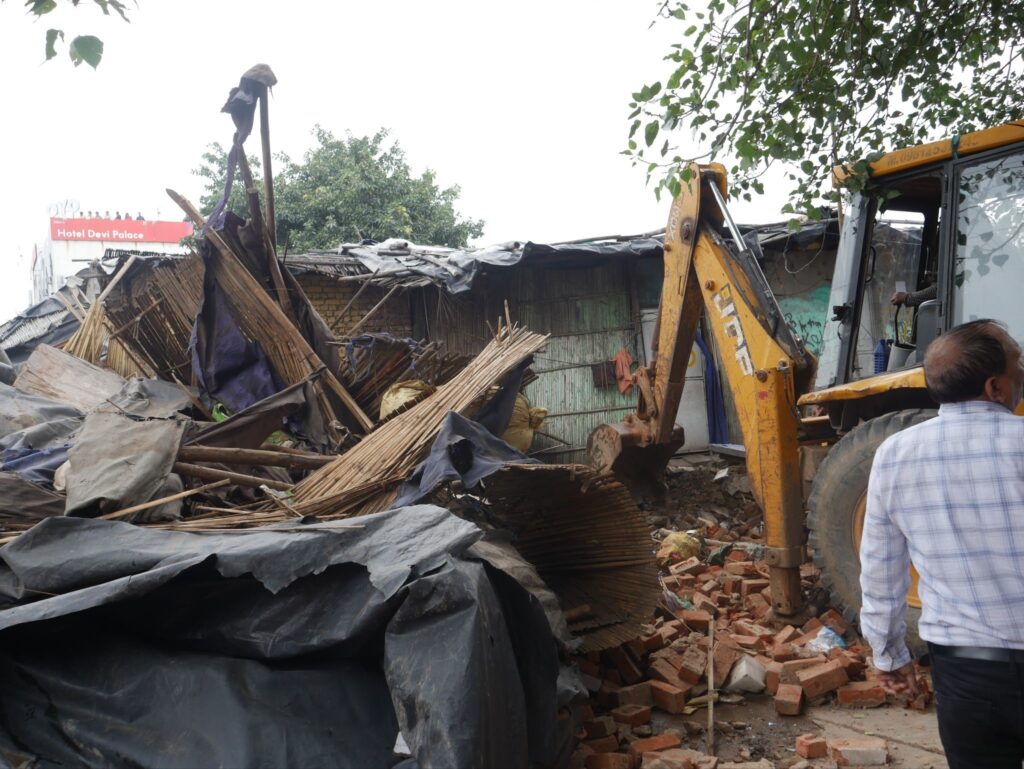
Unlike many similar demolitions of marginalised populations’ homes, the demolition of the Premnagar Basti was initiated not for the purpose of clearing public land, but at the behest of local industrialist Gulaab Singh. In 2013, the Central Market Welfare Association (CMWA) of the market complex opposite the basti filed a lawsuit against the Haryana government and its urban development authority, Haryana Shehri Vikas Pradhikaran (HSVP), complaining that the very existence of the Premnagar Basti was affecting their business adversely. Singh is the president of this association, and also the owner of the Sector 12 market complex.
The same year that the CMWA filed the lawsuit demanding Premnagar’s demolition, the Right to Fair Compensation and Transparency in Land Acquisition, Rehabilitation and Resettlement Bill was passed in Parliament, repealing 1894’s Land Acquisition Act such that every acquisition would require the government to pay compensation to its occupants, or rehabilitate them. Essentially, it meant that there is no such thing in Indian law as a ‘legal forced eviction’ or a ‘legal forced demolition’.
The act was enforced the following year in 2014, but the CMWA’s case was temporarily dismissed by the Punjab and Haryana High Court at the time, as the occupied land in question was not public property at all, but disputed private property that the government had been attempting to acquire for three decades.

Premnagar’s impending demolition has terrorised its residents through much of the last decade, ever since HSVP acquired the land in the mid 2010s (HSVP’s present estate officer, Rakesh Saini, alongside GMDA Nodal Officer and Town Planner R.S. Batth declined comment on the exact date, or any other technical or legal details). Wednesday marked the end of a decade long battle, despite the fact that till date, not a single family has been rehabilitated or compensated by the HSVP as required by the 2013 Act.
In fact, the Ashiana Scheme apartments in sector 47, where the HSVP now promises to house 86 families currently protected from demolition, have sat empty for 15 years. These flats are in a state of utter disrepair, with the HSVP having failed to allot even one of 1,088 flats since the project’s completion in 2010. In 2023, the HSVP announced that these flats would be demolished! The land was set to be resold for high-end commercial use, which the HSVP felt better suited its ‘premium value’; just this year, it was announced that they would not be demolished after all, and Rs. 9 crores were then allotted for their repair!
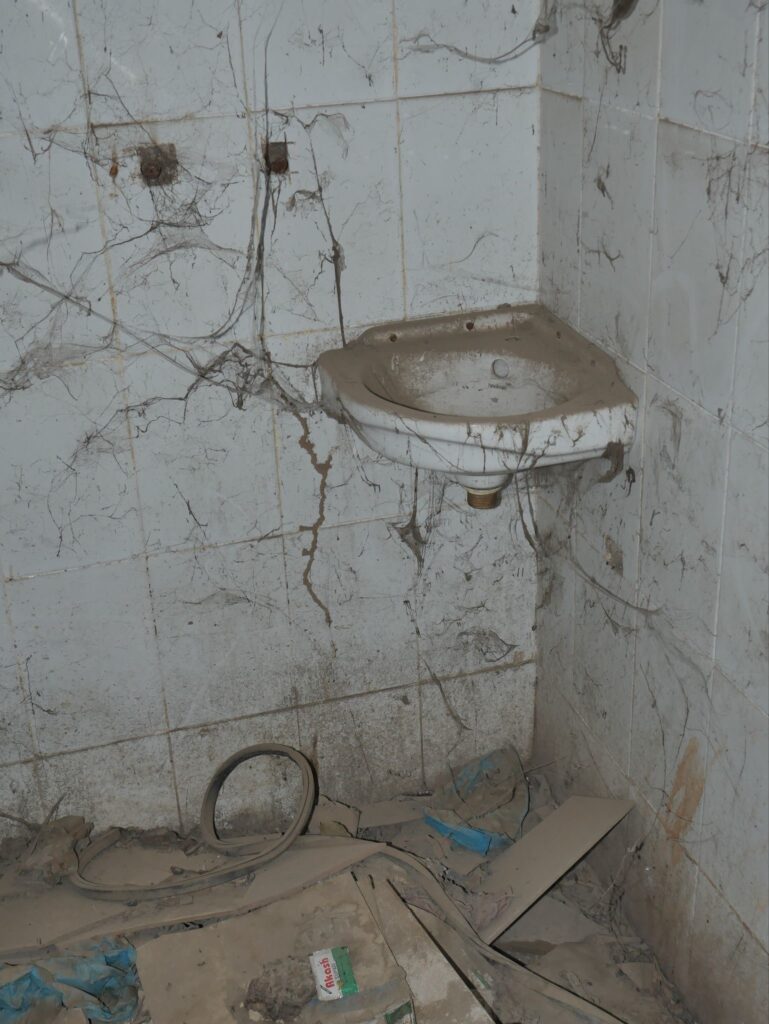
In the High Court’s final judgement regarding Premnagar given in January earlier this year, 204 families had been marked as eligible for rehabilitation in these inhospitable Ashiana Scheme apartments. Now, this number has arbitrarily shrunk to 86, and not a single allotment letter has been given to any of them either.
The demolition drive, which employed the use of a massive armed police force, water cannons, detention vans and a bulldozer—blocking Old Delhi Road for regular commuters through the hours of 10 and 6—was overseen by GMDA’s Nodal Officer for ‘removal of illegal encroachments’, R. S. Batth, a somewhat notorious figure for his attempts at internet fame—through the act of demolition itself.
Batth’s Instagram account, @r_s_batth_dtp, consists largely of vertical short-form videos of himself overseeing various demolition drives in addition to participation in Savarna religious events, with the former ranging from the destruction of street food vendor stalls to the huts and homes of slum dwellers. Batth has built a loyal Instagram following, with over 2,71,000 followers and at least 6 fan pages, and a corresponding internet infamy within less than a year of taking office, seemingly entirely at the cost of Gurugram’s urban poor.
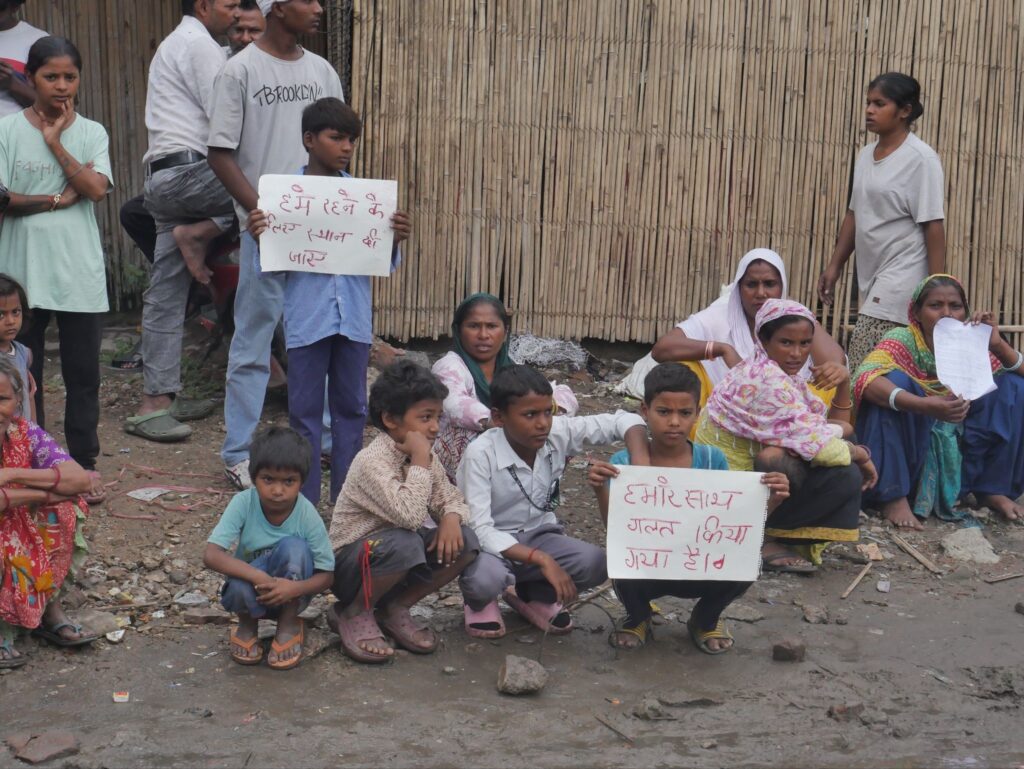
On the 8th of October, as sick children were dragged from their homes and men and women beaten with sticks as they were made to watch their homes being razed to the ground, Batth could be seen recording videos of requesting victims of demolition to have tea or water to calm themselves down. These videos, along with closeups of bulldozer action, were then quickly uploaded to his Instagram page, receiving applause from his following.
Surprisingly though, there are forms of attention that Batth does not in fact, enjoy. When reporters from Sabrang India asked him about the legality of the demolition with reference to the 2013 Act, how, if at all, he planned to rehabilitate the people whose homes he’d demolished as constitutionally required, or why the 120 remaining families earlier promised rehabilitation were suddenly dropped from the list. Batth declined comment on each question, and requested that ‘technical questions’ be directed to HSVP’s Estate Officer, Rakesh Saini instead.
“I am not questioning your legal knowledge. Please ask all these technical questions to the Estate Officer and not me,” said Batth. Saini himself also declined comment on the matter, saying that he would prefer if the matter were discussed with him privately instead.
Interestingly, both authorities also failed to answer how many homes it was that they’d set out to demolish. “It is not possible to say the exact number,” said Saini. “It is somewhere around a hundred and fifty.”
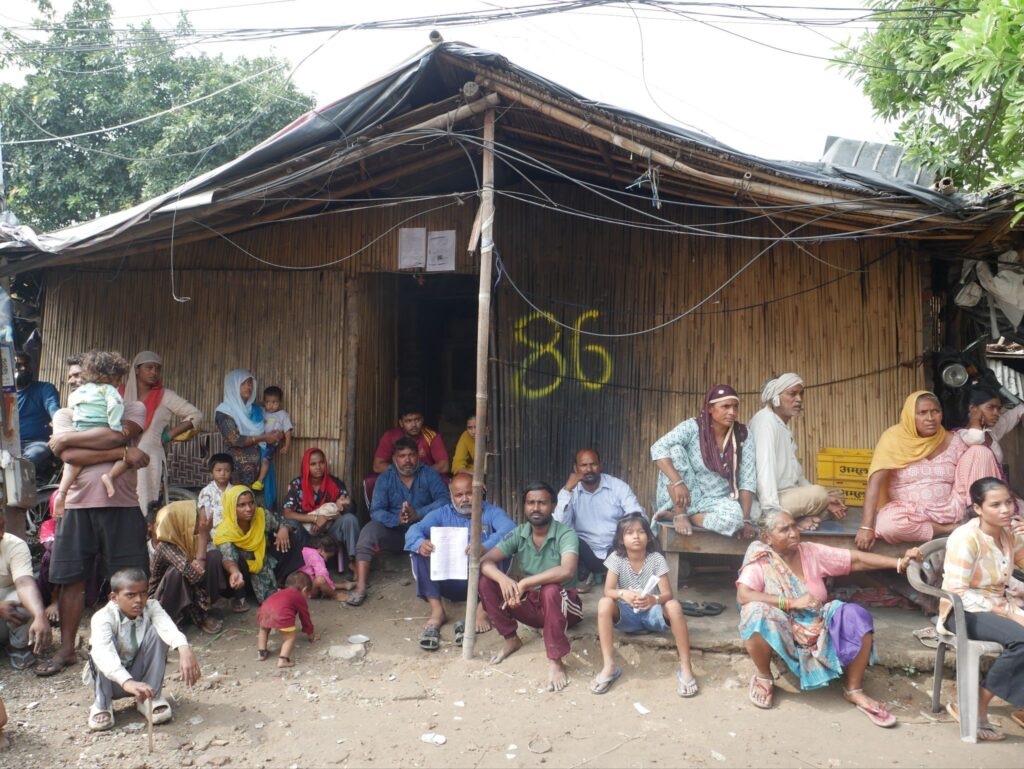
Barring the 86 protected homes, marked out by yellow spray paint on bamboo walls and notices pasted everywhere the eye could see, at least 170 homes would have been planned to be demolished. Till the evening, 50 or so homes were destroyed by the Haryana government, with many families not even being permitted to retrieve their belongings.
“That is 50 year’s worth of possessions,” said Reema Devi, resident of one such home, weeping on the street with her granddaughters beside her. “They expect us to get rid of it in a day.”
“This is all the fault of Mukesh Sharma,” she then added. The BJP MLA had campaigned around Premnagar intensely, promising an end to the battle for Premnagar which had begun during Congress’ tenure.” He promised us this wouldn’t happen. That we would be rehabilitated within two months of his taking office,” said Reema Devi.
While Sharma has never since revisited Premnagar, nor had he replied to the petition sent to him by residents of the basti informing him of the unjust processes of demolition being carried out over there and seeking remedy for the same, he has come very close: On 25th September, Sharma visited the popular Sheetla Mata Mandir merely 2km away from the Premnagar basti, to inaugurate a new building within the temple, and to ensure that no one would sell meat within a four-hundred metre radius of it. These achievements are boasted of on his very own website, mukeshsharma.in.
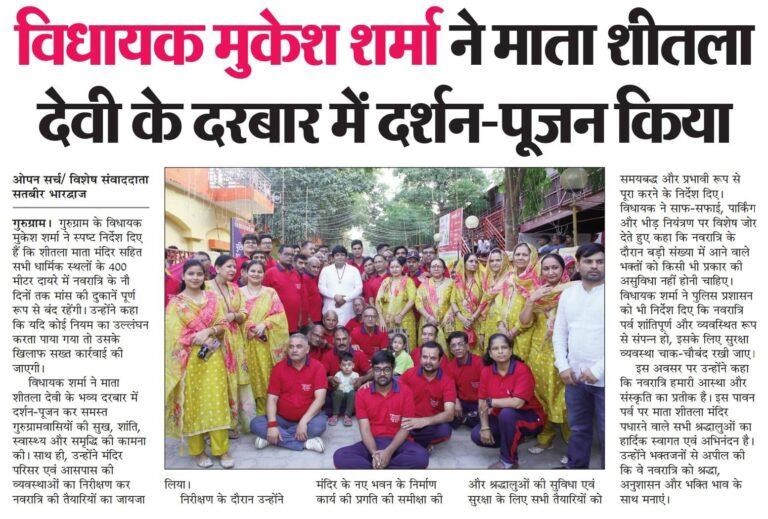
The following day, the police and demolition authorities were set to return to finish their incomplete task of razing over a hundred more homes, but as of 9th October, at time of writing, no further action is taking place. It seems as if now that Batth’s videos have gone viral, the urgency to ‘clean up’ the streets of Gurugram has ceased.
The homes of a few poor Dalit families have little value to the incumbent government beyond cheap publicity stunts and monkey-fights with the opposition; Congress’ mayoral candidate, alongside their advocate, Abhay Jain were both present at the sight of demolition and spoke vehemently against the drive, requesting that the government at least ‘let Diwali pass’ in peace for the families, most of whom make livings through artisan work and seasonal employment. Both left immediately after the police lathi-charged the basti’s protesting crowd, gathered protectively around the urban village.
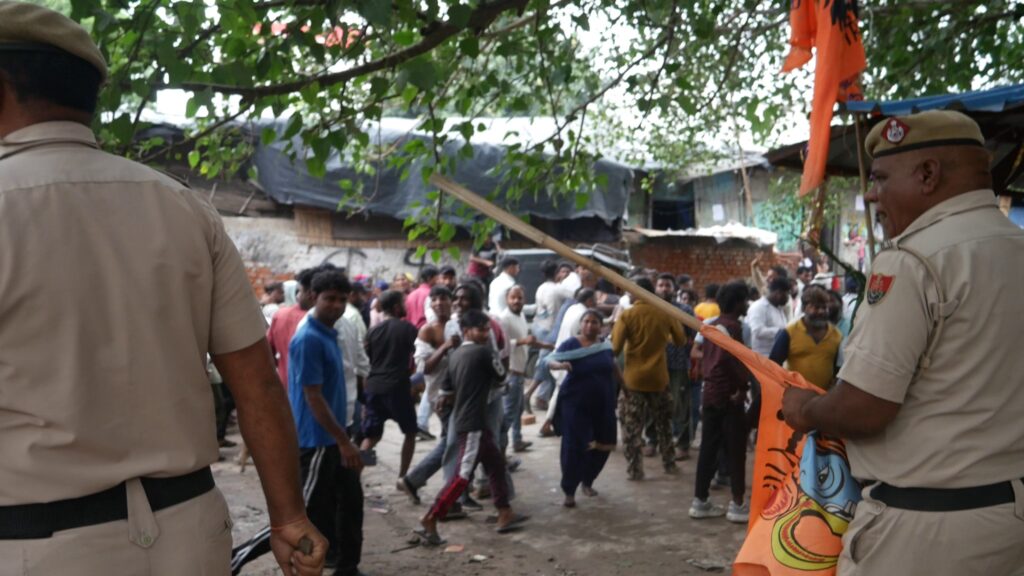
“At this point, I don’t understand anything. I don’t know what to do,” said Muskan, an 18-year-old preparing to become a software engineer, who was one of the key voices among the basti’s youth who have been fighting the demolition threats since the judgment of January 16.
“After today, it feels like nothing we can do matters.”
Muskan was among many young women who very nearly escaped violent detention as police forcefully cleared the homes on the outer periphery of the basti. Her friend, a young girl named Shivani was among five people falsely imprisoned without food or water in a detention van outside for the entire duration of the demolition drive, which continued from early afternoon till the evening. Four of these five detainees were women.
“We did nothing. We weren’t violent, we weren’t obstructing anything. We just asked them not to raze our homes,” said Shivani from behind the grills of the detention van. All the detainees were released past sunset.

For now, the 86 families marked for rehabilitation wait in limbo — their allotted homes in the Ashiana Scheme still locked, decaying, and unfit for habitation. With no timeline or written assurance from the HSVP, uncertainty looms large. Many fear that once the media attention fades, their protection too will quietly dissolve, leaving them next in line for eviction.
(The author is a scholar of religion at Jamia Millia Islamia and a freelance journalist from New Delhi. Additional fieldwork by Vishnu Khanawalia, a reporter and activist from New Delhi.)

